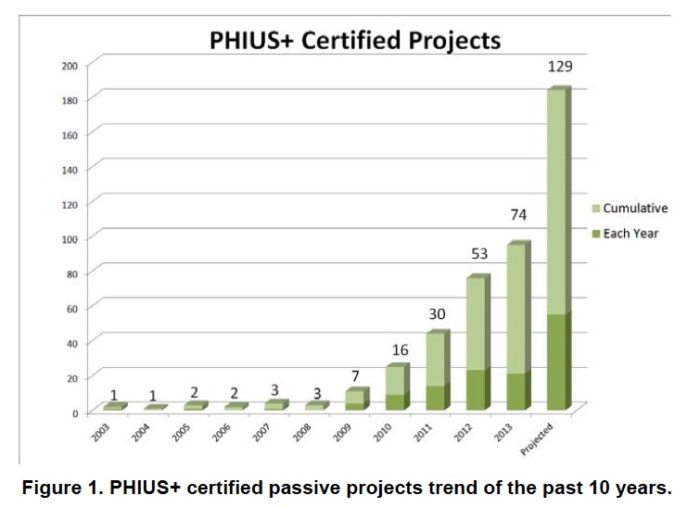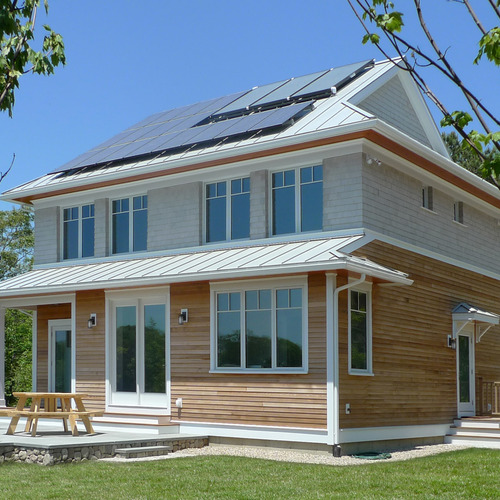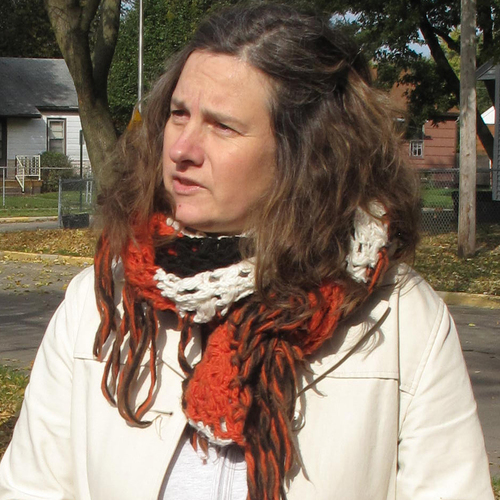Image Credit: PHIUS
Image Credit: PHIUS The generic example of the cost/benefit U curve diagram used to determine the sweet spot for envelope improvements versus renewables.
I make no claim to being an expert on Passive House, but ignorance has never stopped me from expressing my opinion before. Among the major complaints about the Passive House standard is that it has inflexible energy use requirements, and the European-designed program does not effectively address the wide range of U.S. climate zones. This inflexibility often leads those who pursue this certification to install enormous quantities of insulation, particularly under slabs, which raises a variety of questions and concerns about the usefulness of this practice.
The Passive House Institute U.S. (PHIUS) has heard these concerns and has recently released a paper, completed in conjunction with Building Science Corporation (BSC), which includes recommendations on altering the program to be better suited to U.S. climate zones. Succinctly titled “Climate-Specific Passive Building Standards,” this 72-page paper reports on energy and economic models created for a typical three-bedroom home in 111 different locations throughout the U.S.
Using energy modeling, hygrothermal analysis, and cost data, the study identified U curves showing the cost/benefit analysis of energy efficiency improvements for the home in each location.
PHIUS is seeking comments and intends to implement the new standard in the PHIUS certification protocol in early 2015.
As my success in fully understanding the details in the paper was limited, I will leave it to the super geeks who troll this site to dig in deeper and criticize me for my ignorance.
Same core concepts, with some key changes
Although the paper proposes some changes in Passive House requirements, it does not change the core concept, or “three pillars,” of the program – limit on space conditioning loads, limit on total source energy, and building airtightness standards. What the paper does propose is adapting the first two pillars to criteria more appropriate to the range of U.S. climate zones. It leaves building airtightness standards to others.
One important change from the current standard being recommended is for maximum energy use to be calculated based on both building size and occupancy, rather than by size alone. It also suggests a different calculation of floor area, using the interior dimensions instead of calculating to the outside surface of the walls per the ANSI Z765 standard used by RESNET. The paper also recommends increasing allowances for plug loads, recognizing that the current allowances in the Passivhaus standard have been determined to be low when compared to actual use during occupancy.
Regarding source versus site energy, the paper recommends changing the source energy factor for grid electricity from 2.7 to 3.1, roughly the average for the U.S. electric grid. In addition, source energy maximum allowances should be based on occupancy rather than building size, assuming an occupancy count of the number of bedrooms plus 1.
The U Curve
The U curve cost/benefit plots included in the paper show fairly consistent results in most locations: specifically, that energy improvements are cost-effective until you reach about 55% to 60% site energy savings. Above those levels, the hard costs of increased energy savings trends higher, suggesting that the bottom of the U curve is the point at which adding renewable energy systems is a more appropriate investment.
One interesting observation, further reinforcing the value of adjusting the program for the U.S., was that in Europe typical HVAC systems are hydronic, powered by expensive boilers. When building envelope improvements can eliminate the need for an expensive HVAC system, they are appropriate investments. In the much of the U.S., however, HVAC systems are significantly less expensive than in Europe, making it far more challenging to realize significant savings by eliminating those systems through efficiency measures, a common practice in Passivhaus projects.
One interesting observation was that in states with high electric costs, almost every energy upgrade was affordable. Conversely, where energy is cheap, few of the energy upgrades proved affordable. The paper concluded that regional differences in energy costs are much greater than differences in construction costs, suggesting that many decisions on efficiency improvements may be determined primarily based on local utility costs.
Increasing adoption, but still a small market share
One graph included in the paper shows annual and total Passive House projects in the U.S., with a projected total of 129 certified projects through 2014. It is amazing to me how much influence and press PHIUS gets for relatively little traction in marketplace.
One interesting question in the online comment form asks for opinions on the current pass/fail system versus a potential tiered system of certification. The level names they suggest are quite amusing: Emerald, Gold, Plastic, and Coal. Everyone should go for the coal.
I have known about Passive House for quite a while and follow most of the intrigues and developments in the program. The Passive House Institute U.S. (PHIUS) offers several individual designations, including Certified Passive House Consultant (CPHC), Certified Builder, and PHIUS+ Rater. I completed the Rater training in 2014, and although I have yet to work on a project, I look forward to the opportunity to do so in the future. Anyone with the interest and time should read the paper and give their opinions on it to PHIUS.
Weekly Newsletter
Get building science and energy efficiency advice, plus special offers, in your inbox.
















4 Comments
Totally out of context response.
They used partially upgraded occupants in their modeling (section 5.1). I'm sure quite a few builders would like to upgrade their occupants.
People, persons
The few....
You beat me to it
Carl,
You managed to get your blog on the draft proposal for new Passive House standards published before mine. Good job.
If GBA readers are interested in my take on the new PHIUS document, here is a link to my article: Redefining Passivhaus.
BeOpt has been there, done that
Of course PV should be in the mix. If current trends hold, the lowest point on the curve will be a IECC2015 code minimum house with a bunch of PV.
At that point, builders should be fighting against further tightening of the energy code, because it will stifle innovation.
Log in or create an account to post a comment.
Sign up Log in